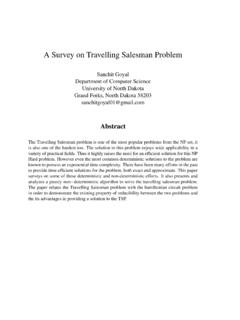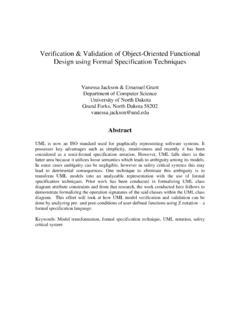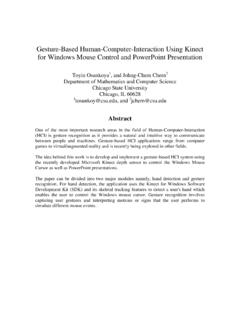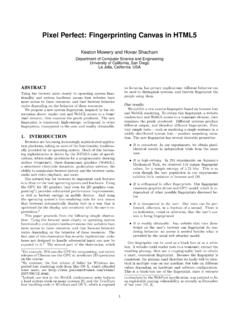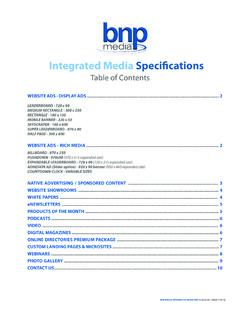Transcription of Location-Based Services Using HTML5 Geolocation and …
1 Location-Based Services Using HTML5 Geolocation and Google Maps APIs Wen-Chen Hu Department of Computer Science University of North Dakota Grand Forks, ND 58202 Naima Kaabouch Department of Electrical Engineering University of North Dakota Grand Forks, ND 58202 Hung-Jen Yang Department of Industrial Technology Education National Kaohsiung Normal University Kaohsiung City, Taiwan Xiwei Wang Department of Computer Science University of North Dakota Grand Forks, ND 58202 Abstract A Location-Based service (LBS) is a service based on the geographical positions of mobile handheld devices such as smartphones or tablet computers. Though Location-Based Services are popular and useful, most developers are not familiar with its development because it used to be complicated and difficult. However, the introduction of HTML5 Geolocation and various map APIs (Application Programming Interfaces) has made the LBS construction easy.
2 Geolocation , a feature of the HTML5 specification and API, is used to pinpoint the user s location without needing the GPS support directly. Additionally, one of the popular map APIs is Google Maps APIs, which provide a powerful and convenient tool for map applications. This article introduces the HTML5 Geolocation and Google Maps APIs by constructing a simple LBS. LBS developers quickly learn how to build an LBS application by studying this article. 1 1 Introduction Mobile computing research evolves constantly and swiftly. New mobile devices, technologies, methods, or applications are introduced every day. One of the mobile applications, Location-Based service (LBS), has attracted great attention recently. A Location-Based service is a service based on the geographical positions of mobile handheld devices such as smartphones and tablet computers. Two of the LBS examples are finding a nearby ethnic restaurant and comparing prices of a product from different stores.
3 The future of the LBS is bright according to the following market research: Gartner (2012, October 11) expected almost 800 million Location-Based service users worldwide by the end of the year 2012 and revenue generated by consumer Location-Based Services is forecast to reach $ billion in 2015. Owing to different factors such as increasing smartphone adoption, continued growth of mobile advertising, and the wider coverage and higher speeds of mobile networks, the Location-Based Services revenue is expected to reach $ billion in 2015 up from $ billion in 2010 according to Pyramid Research (2012, May). Federal Communications Commission (2012, May 25) reported that as of May 2011, 28 percent of adult Americans used mobile LBS and LBS are expected to deliver $700 billion value to consumers and business users over the next decade. Though Location-Based Services are popular, most developers are not familiar with their development because it used to be complicated and difficult.
4 However, since the introduction of HTML5 Geolocation and Google Maps APIs, LBS development becomes a kind of Web development and many IT developers are already familiar with Web development. This research builds a simple LBS application by Using HTML5 Geolocation and Google Maps APIs. Detailed design and implementation are described in this paper. IT workers could quickly join the LBS development after studying this article. The rest of this paper is organized as follows. Section 2 gives a generic LBS architecture and an LBS example showing how LBS work. The proposed LBS application is given in Section 3, which includes two sub-sections: the system structure and the simple geographical database of the proposed system. Section 4 explains how to retrieve and update locations by Using HTML5 Geolocation and PHP (Hypertext Preprocessor). The query processing is described in Section 5 including code of applying Google Maps APIs.
5 The final section summarizes this study and gives possible LBS projects. 2 Location-Based Services (LBS) This section introduces Location-Based Services including a generic LBS architecture and an LBS example. 2 An LBS Architecture A Location-Based service is a service based on the geographical position of a mobile handheld device (Kupper, 2005; Kolodziej & Hjelm, 2006). Two of the LBS examples are (i) finding a nearby ethnic restaurants and (ii) locating a nearby store with the best price of a product. A system structure of Location-Based Services , shown in Figure 1, includes five major components (Steiniger, Neun, & Edwardes, 2006): (a) Mobile handheld devices, which are small computers that can be held in one hand. For most cases, they are smartphones. (b) Positioning system, which is a navigation satellite system that provides location and time information to anyone with a receiver.
6 (c) Mobile and wireless networks, which relay the query and location information from devices to service providers and send the results from the providers to devices. (d) Service providers, which provide the Location-Based Services . (e) Geographical data providers, which are databases storing a huge amount of geographical data such as information about restaurants and gas stations. Figure 1: A System Structure of Generic Location-Based Services . An LBS Example The previous descriptions gave a generic LBS system structure. To help readers understand LBS, an example of our proposed system is given step by step as follows: 1. The tablet computer (a) includes our application of finding classmates on the go. 2. The user submits a query of finding his/her classmates of CSci457 along with the location information from a positioning system (b), HTML5 Geolocation in this case, from the application program. 3. The application program calls the server-side programs (d) located at the Aerospace School of the University of North Dakota along with the location information via mobile or wireless networks (c).
7 3 4. The programs at the servers perform the searches Using a MySQL database (e) which stores geographical data. 5. The results such as a map with markers or directions are sent back to the user. A nice introduction of LBS technologies and standards is given by Wang, Min, & Yi (2008, May 19-23). 3 The Proposed Location-Based Service The main purpose of this article is to explain how to implement an LBS application by Using HTML5 Geolocation and Google Maps APIs, so the proposed LBS application is made simple on purpose. It is to find classmates, who are constantly moving. For example, an assignment is due tomorrow and a student is urgent to find a classmate to help solving his/her assignment problems. The proposed LBS application keeps track of the whereabouts of the classmates, who have signed up the application, by Using the methods watchPosition and clearWatch of HTML5 Geolocation .
8 Once the classmates locations are located, the direction between the student and the selected classmate is then given by Using Google Maps APIs. The System Structure Figure 2 shows the system structure of the proposed system, which can be shared by many users. In order to use this system, users have to sign up first by entering their information such as names and classes. Once the application is running on a user s browser, he/she can start querying the whereabouts of his/her classmates. At the same time, his/her location information will be updated from time to time in the server. Figure 2: System Structure of the Proposed System. Query and/or location Server Query results Query and/or location Client #n Browser Client #s Browser Client #1 Browser .. Geographical database LBS software Geographical data 4 Figure 3 shows the workflows of the proposed method. The users/clients communicate with the server via two paths: If the user does not submit a query, his/her location information is sent to the server automatically from time to time as long as the application is active.
9 If the user submits a query along with his/her location information, the query results such as walking directions will be sent back from the server. Figure 3: Workflows of the Proposed Method. The Geographical Database Geographical databases are usually provided by a third party such as GeoNames ( ). This project creates its own simple geographical database, GeoDB, as shown in Figure 4, which includes three tables: (a) Users table, (b) Courses table, and (c) Enrollments table. The attribute time of the Users table is used to validate the location, , the location is valid only if it was updated within one hour. PID Name Location and Time Latitude Longitude Time 1 Poke Mon 20:59:11, 03/17/2013 .. n Digi Mon 12:34:29, 03/10/2013 (a) CID Name Credit Hours CSci260 Web Programming 3 .. CSci515 Data Engineering 3 PID CID Semester 1 CSci457 13S .. n CSci370 12F (b) (c) Figure 4: Geographical Database, GeoDB, Used in This Project Including (a) Users Table, (b) Courses Table, and (c) Enrollments Table.
10 Data Result Query & location Location Query & location Location Client LBS software at server LBS software at server Geographical database Geographical database 5 The Users table is created by Using the following SQL (Structured Query Language) commands (Oracle, ): mysql> CREATE TABLE Users ( > PID int NOT NULL AUTO_INCREMENT, > name VARCHAR(64), > latitude DOUBLE, > longitude DOUBLE, > time DATETIME, > PRIMARY KEY (PID) ); Other two tables can be created by similar commands. Users have to sign up for the system and enter their information such as names and classes taking before Using the application. The attributes of latitude, longitude, and time of the Users table will be updated automatically from time to time while the application is active. The following SQL command is used to enter the user data when signing up: mysql> INSERT INTO Users ( name, latitude, longitude, time ) > VALUES ( 'Poke Mon', , , NOW() ); The HTML5 Geolocation watchPosition method invokes the update command whenever user position changes.



